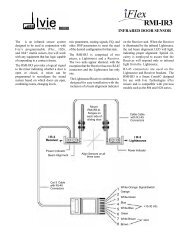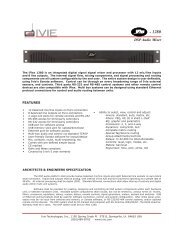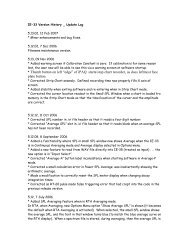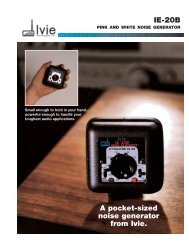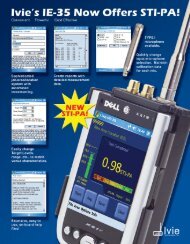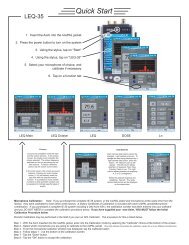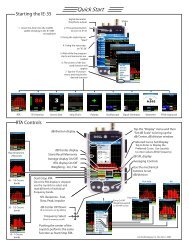1026 Software and Programming Getting Started - Ivie
1026 Software and Programming Getting Started - Ivie
1026 Software and Programming Getting Started - Ivie
Create successful ePaper yourself
Turn your PDF publications into a flip-book with our unique Google optimized e-Paper software.
<strong>1026</strong> Manual<br />
<strong>Ivie</strong> Technologies, Inc. __________________________________________________________<br />
Successful Power Up<br />
The HUP45-32 universal power supply is used with the <strong>1026</strong> <strong>and</strong> provides a broad mains voltage operating<br />
range: 100 to 240 VAC, 47 - 63 Hz. Successful powering of the <strong>1026</strong> can be verified by the<br />
lighting of the power indicator LED. When first powered on, the <strong>1026</strong> initiates a self test which<br />
checks a number of their operating parameters to verify proper performance.<br />
Channel Inputs<br />
All <strong>1026</strong> channel inputs are electronically balanced. The preamplifier design provides a very low noise<br />
input with very high common mode rejection. The input is designed to work with a source impedance<br />
of from 50 to 600 Ω <strong>and</strong> provides excellent RF protection. The actual input impedance is 2100 Ω.<br />
All channel inputs can accommodate either microphone or line level inputs. Switching from mic to<br />
line level input is a software function. The input preamp gain trim has a range of from -20 dB to +50<br />
dB. With the input gain trim turned up to + 50 dB, (dynamic mic position), the input terminals are<br />
connected directly to the preamp. Hotter microphones will require preamp gain trim settings of less<br />
than +50 dB. A line level input will require a channel input gain trim setting of approximately 0 to<br />
+10 dB (40 to 50 dB less gain than a mic level input), since line levels are typically hotter than mic<br />
levels by about 35 to 40 dB. The preamp gain stage of the <strong>1026</strong> provides a very high common mode<br />
rejection ratio. The greater the common mode rejection, the greater the degree of immunity to common<br />
mode noise induced in long cable runs between the <strong>1026</strong> <strong>and</strong> the input connector.<br />
Connecting a Dynamic (Moving Coil) Microphone<br />
A st<strong>and</strong>ard dynamic microphone connects to the <strong>1026</strong> via the Euro connectors located on the rear<br />
panel. Pin one of the microphone is connected to the ground terminal on the connector. Pins two (+)<br />
<strong>and</strong> three (-) are connected to their respective terminals. Phantom Power should be OFF. A typical<br />
connection is shown in Figure 2, below:<br />
Dynamic (Moving<br />
Coil) Microphone<br />
Input 1<br />
Figure 2<br />
INPUT SETTINGS<br />
Phantom Pwr: OFF<br />
Preamp gain trim set to -50dB<br />
Page 3






